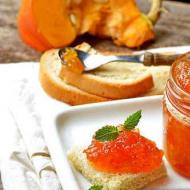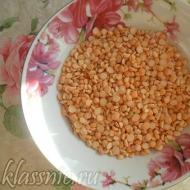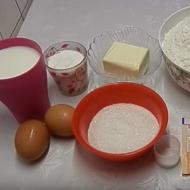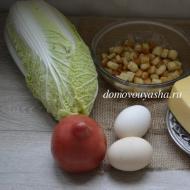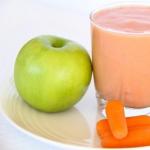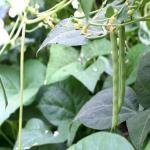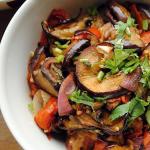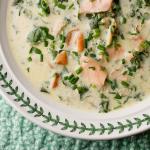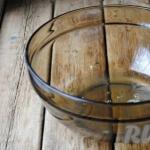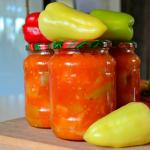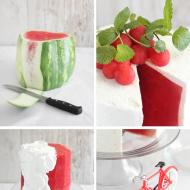
Strawberries in their own juice without sterilization. Strawberries in your own juice for the winter: recipes How to make Victoria in your own juice
Strawberry preparations are in great demand in winter, because the aromatic berry is both healthy and pleasant to the taste. Many delicious preparations are made from strawberry fruits: jams, jellies, preserves. The berries are dried and frozen. You can also prepare them in their own juice.
This method is labor-intensive, however, the result rewards all efforts. The final product is obtained in color and taste as close as possible to the fresh summer version.
Our recommendations will help you properly cook berries in their own juice for the winter. We will provide the best recipes.

Preparing for the cooking process
The first thing you need to do is prepare the glass container. It is most convenient to use jars that have a capacity of half a liter (you can also use liter ones, but no more). Glass containers are washed thoroughly using soda and rinsed. Then they are sterilized in the oven or under steam.
The lids are also thoroughly washed and sterilized.

It is better to take strawberry berries that are not too large, but not small either. The best option for this kind of preparation is medium-sized fruits. They are sorted out and the stalks are removed. Get rid of spoiled and rotten specimens. Since strawberries grow in garden beds, bending towards the ground, they are often soiled with soil. In this regard, it does not hurt to wash the fruits twice under good pressure of running water. Peeled berries are placed on a cloth to dry.
Later they will be placed in a deep container. They are covered with granulated sugar for at least 12 hours (it is advisable to do this at night). During this time, the berries release a sufficient amount of juice.
Methods for preparing strawberries in their own juice. Canning
Method one
For a kilogram of strawberries, take two hundred grams of sugar (the proportion must be five to one).
The following sequence of actions is carried out with these two ingredients:
- Whole sorted fruits without fruit stalks are placed in dry, sterilized glass containers.
- Sugar is also added to it.
- Fruits with granulated sugar are infused in the refrigerator throughout the night.
- By morning, the berry settles (decreases in volume), releasing juice.
- The berry, which has given up some of its juice, takes up less space, so the strawberry fruits are redistributed among the glass containers at the housewife’s disposal.
- After such redistribution, there will be fewer filled jars, since the laid out fruits should reach the level of the jar hangers.
- The jars are covered with clean, dry lids.
- Next, they are placed in a wide cooking container (this version of the dish will allow you to place a larger number of jars with fruits). The pan is filled with warm water: the water level in the pan should not exceed the hanger of the glass container.
- Initially, the pan is placed on high heat.
- The water is brought to a boil.
- The flame of the fire is kept to a minimum. Jars placed in water should boil: the sterilization process takes about five minutes.
- The jars are removed from the water and closed turnkey.
- If there are suspended granulated sugar crystals, the glass jar is turned upside down until they are completely dissolved.


Method two
For 600 grams of strawberries you will need one and a half cups of granulated sugar.
- Pour cold water over carefully sorted fruits without stems (soaking them for fifteen minutes is enough).
- Drain the liquid and rinse using running water.
- Place the washed fruits in a colander.
- A couple of tablespoons of granulated sugar are sent into the prepared jars.
- Strawberries are placed on top, which are covered with a new layer of sugar (take one and a half spoons).
- Alternating a layer of sugar with a layer of strawberries, fill the entire jar.
- In order to fill the existing voids, the jar is covered with a lid, turned over and gently shaken.
- The glass container with the product is covered with a piece of gauze.
- The contents of the jar are left to infuse for 3-4 hours.
- After this time, the fruits will release their juice and settle, and the granulated sugar will dissolve a little.
- Glass jars covered with lids are sterilized for half an hour over low heat (violent boiling should not be allowed).
- Roll up the jars and turn them upside down. There is no need to wrap them up. After the natural cooling process, store in a cool place.

Method three - using citric acid
Ingredients: 350 grams of sugar, 1 kilogram of strawberry, 5 grams of citric acid.
- Thoroughly washed berries are placed in a deep bowl and sprinkled with sugar.
- The fruits infuse all night.
- The resulting strawberry nectar is poured into a free container.
- This container with juice is heated, the juice is brought to the point of boiling, but it should not boil, so it is important to remove the pan from the heat in time.
- Lemon is added.
- Strawberries are placed in prepared jars. The hot nectar with which it is poured should not reach the edge of the container by about a centimeter.
- You need to lay a cloth on the bottom of the pan (you should take a wide container). Pour water into the container and bring it to a boil.
- Jars of berries are placed in a container and sterilized for fifteen minutes.
- Glass jars with the product are rolled up and cooled. There is no need to turn them over.
- Storage is carried out in a basement or other cool place.

Method four - with lemon juice
For 0.7 kg of fruit, take 0.2 kg of sugar, 0.1 liters of water and half a lemon.
- Select high-quality berries (in this case large fruits are used) and prepare them for the cooking process.
- Cut the fruits into halves.
- Place in a single layer in a bowl. Sprinkle with granulated sugar. Next, repeat the procedure of alternating layers until all the berries are laid out. It should be remembered that only half of the allocated amount of sugar is used to pour the berries.
- A bowl of strawberries is covered with cling film.
- This dish is placed in a place where the sun's rays penetrate well.
- After 1.5 hours, enough strawberry juice will be released.
- Strawberries with juice are placed in a cooking container, water is added.
- The remaining sugar is poured in there.
- Half a lemon, diced, is added to the strawberries.
- The pan is sent to the oven and simmered over low heat for 15 minutes. The water should not boil.
- After this, the lemon pieces are removed and discarded. The role of the lemon is to release the juice and give the product citrus notes.
- The contents of the pan are distributed into sterile jars that are locked with a key. Closed jars are wrapped in a warm blanket.
- Store in a basement or cool room.

Method five - preparation without sugar
If you want to get the most natural product possible, you can make it without adding sugar.
For such a preparation of a strawberry product, only the fruits of the above-mentioned berries are required.
- Jars that have been previously sterilized are filled with strawberries.
- They are placed in a water bath. Under the influence of high temperature, the fruits will gradually become smaller in size, which is due to the release of juice.
- As the size of the berries decreases, new fresh fruits are added.
- The berries should be simmered over low heat until they settle.
- If the container is sufficiently filled, final cooking is carried out within fifteen minutes.
- Banks that have undergone sterilization are screwed on a turnkey basis.
Alexander Gushchin
I can’t vouch for the taste, but it will be hot :)
Content
This fragrant summer berry has many fans; people await its appearance in garden beds and forest glades in preparation for harvest. Afterwards, the search arises for the ideal way to preserve each berry until next summer. Jam, jam, compote, frozen puree. How to prepare strawberries for the winter quickly, but tasty and as healthy as possible?
How to make strawberry preparations for the winter
All the key rules regarding sterilization of jars, peeling of berries and subsequent sealing of preservation are also relevant for these fruits. If you decide to cook the berries by pouring their own juice, you can do without cooking - this will save time spent at the stove. However, recipes of this type still have several nuances:
- Take small containers: jars, containers, etc. The ideal volume is considered to be 0.5 liters - it will not allow the product to spoil. In rare cases, 0.75 liters will do, but liter containers are already too large.
- If you plan to maintain the density and integrity of strawberries soaked in their own juice, take only clean fruits that do not require washing.
- The amount of sugar can be minimal (up to a glass for 2 kg of berries) - the duration of infusion will play a key role. Professionals advise storing the preserves overnight.
- Not all housewives understand turning a can over after seaming. You only need to leave it upside down for a few minutes. If syrup does not appear around the lid, you can place the container in a more usual way and cool. If leakage begins, this indicates that the container is not closed correctly and needs to be re-rolled. There is no need to cool with the lid down.
- Special attention should be paid to re-closing: if you have removed the lid, all juice or syrup should be drained, brought to a boil again and filled the jar with it again. Afterwards you can roll it up and test it for strength by turning it over.

What can you make from strawberries for the winter?
All recipes of this type differ only in the proportions of the 2 key ingredients and the duration of infusion of the workpiece. Some of them involve the introduction of an additional preservative: citric acid, cloves, cinnamon, and even flavoring (vanillin is considered the most popular). If you understand the basic rules for preserving strawberries in natural juice, you will be able to create your own recipe.
Strawberries for the winter with sugar
This is the fastest and easiest dessert, it only takes half an hour to prepare. There is no need to cook the syrup, the number of manipulations carried out on the berries is also minimal, so such strawberries in their own juice for the winter are a lifesaver for those who want to preserve them without unnecessary pain. You need to prepare small containers (preferably containers with lids, not jars) and find some free time. The proportion of sugar to berries is from 1:3 to 1:2 at your discretion. There are no other products, so the list is not provided.
Preparation:
- Do not wash the berries, remove only the stalks (without sepals), cover with sugar.
- After 8-10 hours spent in the cold, shake the fruits and place them in containers.
- Pour in your own juice and put in the freezer.

Strawberry juice with whole berries
This recipe is difficult to master, but if you master it, it will become one of the main desserts on your table. This type of preparation of strawberries for the winter requires concentration, attentiveness, and perseverance. It will take a lot of time to prepare the fruits - here lies the secret of success. The list of ingredients is short:
- fresh firm strawberries – 1.1 kg;
- sugar – 0.25 kg.
Preparing strawberries in their own juice for the winter:
- Rinse the berries with a stream of water, peeling each of them with your fingertips. An alternative method would be to place a small bowl into which a handful of fruits are poured and washed in a couple of minutes. It cannot be kept in water for a long time.
- Dry individually with a paper towel, let sit on a wire rack - spread in a very thin layer, with a small distance between the fruits. Do not remove the sepals.
- Wipe the inside of the pan or enamel basin with paper towels. After making sure the container is dry, move the fruits there. Scatter half the sugar on top and forget for 6 hours.
- Sterilize small, clean jars and cool until warm.
- Fill containers with berries. Boil the released juice, pour it in and cover.
Strawberries in syrup for the winter
The key difference from the previous recipe is the amount of sugar that turns the fruit’s own juice into a thick syrup. He will be responsible for how long the workpiece can be stored. If you need to preserve strawberries in their own juice for the winter, this method is ideal. It is better to use jars of a minimum volume - up to 0.75 l, otherwise the taste and appearance of the product may not be what was expected.
You will need:
- fresh wild strawberries – 2.3 kg;
- sugar – 1 kg;
- vanillin - on the tip of a knife.
According to this recipe, strawberries in their own juice are prepared for the winter like this.
This is not the first year that strawberries in their own juice have helped me a lot; I definitely try to pack a few jars for the winter. It turns out almost like fresh - dense, elastic, with a wonderful strawberry aroma and natural taste of berries. For those who do not like very sweet jam, a recipe for strawberries in their own juice will be a pleasant discovery, and for thrifty housewives another opportunity to preserve a harvest of delicious berries. I seal the strawberries with sugar without adding water so that the syrup is concentrated. I select small berries, then there is no need for long sterilization.
Recipe for strawberries in their own juice
Ingredients:
- Strawberries – 400 g;
- sugar – 200 g;
- cans with a volume of 0.25 l. - 0.3 l.

How to roll up strawberries in their own juice for the winter
I sort through the collected strawberries, removing spoiled, soft ones with greenish noses. I tear off the tails, pour them into the kitchen sink, and fill them with cold water for a few minutes. I place clean berries in a colander.

After about ten minutes the water will drain. I transfer the berries to a dry pan or bowl, sprinkle each layer with sugar. I cover and leave for several hours or until the morning if the strawberries were picked in the evening. You can stir two or three times so that the sugar melts better and more juice is formed.

By morning, the berries will be almost completely covered with juice. It’s more convenient for me to prepare canned strawberries for the winter in small jars; I take 0.25 or half-liter jars. I wash it with soda, heat it over steam, and boil the lids.

First, I put the berries in jars, without juice. I fill it up to the shoulders or almost to the neck, fill it with juice to the top, leaving a couple of centimeters from the edge.

I place a towel at the bottom of the pan, folding it into several layers. I place the jars not close to each other, cover them with lids without twisting them. I fill the jars with water to about two-thirds of the height of the jars, so that when boiling, steam does not get under the lids. Over low heat, bring the water to a boil, sterilize 0.25-0.3 liter jars for 15 minutes, half-liter jars for 25 minutes.

I take it out carefully, holding it with a towel. I twist it right away. I turn it upside down, thus checking whether the lid is screwed on well. There should be no air bubbles inside, and no syrup leaks outside.

If everything is ok, I leave it to cool. After a day, I move it to a dark closet or take it to the basement, away from sunlight and heat.

In winter, strawberries in their own juice are used just like fresh ones: in baked goods (for open pies), all kinds of desserts, compotes, as an addition to cheesecakes, pancakes, and ice cream. Good luck with your winter preparations!
Strawberries in their own juice for the winter, prepared without cooking, will definitely come in handy on long winter evenings with a cup of tea or at a children's party. Perhaps strawberry milkshakes with ice cream are the most delicious attribute of any children's party, student party, or buffet.
In winter and autumn, fresh berries cannot be found, so during the fertile season you need to stock up on strawberries, and be sure to prepare the berries in their own juice.
Preparations for the winter from strawberries are unpretentious in technology; the most inexperienced cook can handle them.
The resulting strawberry juice will be tasty and concentrated, and the berries will be useful for decorating ice cream and cakes.
Strawberries in their own juice for the winter without cooking
Products:
- strawberries - 2 kg;
- sugar - 1 kg;
- lemon - 1/2 pcs.
How to cook strawberries in their own juice with sugar and lemon without cooking - step-by-step recipe with photos:
Crumpled, overripe strawberries will release juice faster, but a preparation of crushed berries looks pathetic and is perceived as a failed culinary experiment. To be able to proudly display a jar of rolled berries on the table, you should choose beautiful whole dark-colored strawberries.
The berries are sorted, the damaged ones are put aside for compote. The tails are removed and the strawberries are washed.

Pour 4-5 tablespoons of sugar into the bottom of the pan and smooth out the sweet layer.

Place strawberries in one row. Squeeze lemon juice and pour over berries. Do this once, taking all the juice from half a lemon.

Sprinkle the berries with granulated sugar and place the next layer of strawberries on top. This method allows you to get the maximum amount of juice without crushing the berries.

When all the strawberries are in the pan, pour out the remaining sand. Cover the pan with cling film. Strawberries are placed in the refrigerator for 12 hours.

Sometimes hot weather allows you to get strawberry juice in a couple of hours: the pan with the berries is left on the table, and the sugar very quickly draws all the liquid out of the strawberries.

Sterilize 4 half-liter jars. The same number of berries is placed in each jar, the juice is poured to the level of the hanger.

Place a thin towel on the bottom of a wide pan and place the jars. The water should reach almost to the hangers of the jars of berries.

Cover the jars with sterilized lids. The water is heated, sterilization begins from the moment the liquid boils in the pan.
Sterilization time is 15 minutes.

Carefully take out the jars of strawberries in their own juice and roll them up. The preparations for the winter are turned over and covered with a small blanket.
The cooled jars are transferred to a cool room. In a good cellar, strawberries in their own juice can be stored all winter until spring.

Now you know the simplest, classic recipe for strawberries in their own juice with sugar and lemon without cooking. It’s very easy to prepare such a delicious sweet and aromatic delicacy. All that remains is to buy berries, prepare preserves and wait for winter.
Video: Recipe for strawberries in their own juice for the winter
Cooking secrets and tricks
- The cocktail option is the main one for using canned strawberries with whole berries in their own juice, but based on it you can make raw strawberry cheesecake, jelly cake filling, and marmalade.
- Try to take whole, ripe berries; it is advisable that they were picked from the garden on the same day.
- In winter, cooked strawberries in their own juice are used to make various pastries or dumplings. And from delicious concentrated strawberry juice - aromatic fruit drink.

Features and shelf life
Strawberry preparations should be stored in a dark, cool place for no more than 1 year. Otherwise, their nutritional value decreases.
Dried strawberries are well stored in a place inaccessible to sunlight and pollution. It should be placed in fabric bags and stored in a suspended state for ventilation. The worst enemy of “drying” is moths. Therefore, in the storage room you need to use special products against harmful insects. It is also necessary to periodically check bags of dried berries, separating spoiled ones.
Strawberry chips can be stored indoors in glass containers. To remove possible condensation, place a paper napkin under the lid of the container.
It is better to store pureed berries in the basement or in the refrigerator.
Jam can be stored in the freezer for six months. And the started container should be kept in the refrigerator.
Strawberries prepared for the winter in their own juice can delight you with their unique taste and aroma all year round.
Such berries (especially without sugar) are no less healthy than fresh ones. They can be used for various desserts, compotes, and jams and strawberry preserves are a wonderful treat for children and adults on autumn and winter evenings.
Summer has come. It's time to go to the country and pick everyone's favorite berry - strawberries. But what to do if you want real strawberries not only in summer, but also in winter? The answer is simple. For lovers of yummy things, there is a special recipe for canned strawberries in their own juice. Opening a jar of your favorite berries in winter will give you a taste of summer. Strawberries prepared according to this recipe retain their taste and aroma.
The canning recipe is very simple. All you need is:
- strawberries (calculated at 600 g per 0.5 ml jar);
- sugar;
- water for sterilization.
How to cook strawberries in your own juice, a simple recipe
The first thing we do is sort out the strawberries, remove the spoiled ones and tear off the tails.
After which you need to rinse them very well, otherwise there is a possibility that mold will form in the jar in winter.

When the strawberries are ready, we can actually start canning. To do this, scatter the berries into clean and dry jars, alternating layers: strawberries - sugar - strawberries, etc. Sprinkle sugar depending on how sweet you like it. In our case, this is 1 tbsp. l. on top of each layer.

Having placed the strawberries in jars and sprinkled them with sugar, we leave them to let out the juice. This takes approximately 6 hours, but can be left overnight if desired.

When enough time has passed and the strawberries have released their juice, you can continue the canning process.

The next step is sterilization. You need to take a pan with a towel on the bottom. Place jars of strawberries in it, covering them with lids. If all the jars don't fit in one go, save them for the next time.


Pour water into a saucepan up to the hangers of the jars, bring to a boil and sterilize for 20 minutes. Then we take it out using tongs and roll it up.


Be sure to check that the lid fits tightly after rolling. To do this, simply turn the jar on its side and see if the syrup leaks.


